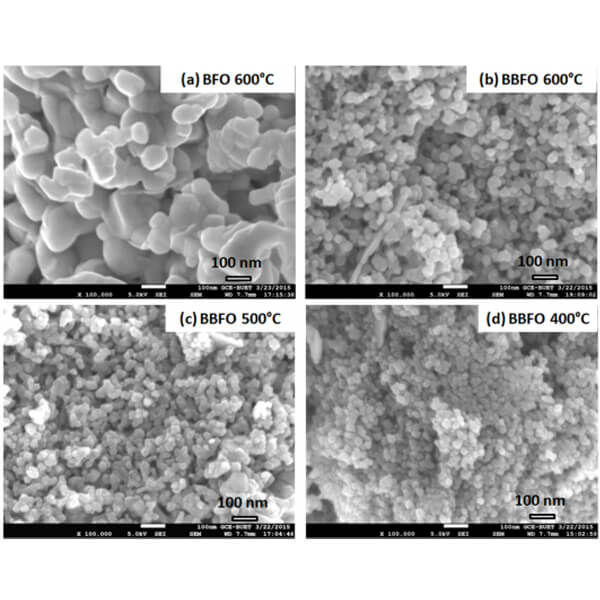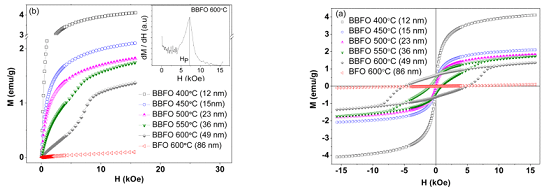Electroceramics has been a vital component for the development of electro-mechanical industries for the last few decades and continues to play a vital role in the modern industrial growth particularly in telecommunication and memory devices. Magnetic, ferroelectric and multiferroic ceramics, represented by the chemical formula ABO3 , AB2O4 , AB5O12 , AB12 O19 , attract enormous scientific interest for their multi functionality in the magnetic, electronic and microwave applications. With the emergence of nanotechnology, the above mentioned materials in their nano scale dimension have found utility in multi-dimensional cutting edge technologies such as efficient PV cell, anti bacterial activity, photo catalytic activity, non-volatile memory devices, environmental pollution control, imaging techniques, targeted drug delivery and cancer therapy due to their tunable band gap and extra ordinary high surface reactivity.
For the last few years our department has acquired sufficient experience in various functional electroceramic research works with valance compensated solid solution systems of the type A 1-x Ax 'B1-x Bx 'O3 , A1-x Ax 'B5-x Bx 'O12. Valence compensated Perovskites and Spinels are formed by A and B type substitution maintaining the charge neutrality. These type of heterostructures synthesized in the nano structured form are studied in detail using state-of-the-art facilities at the department. These materials have potential technical applications in various devices. Our recent research includes synthesis and characterization of multiferroic materials like BiFeO 3 with various doping agents, photo catalysts like BiVO 4 , CeO 2 , TiO 2 , ZnO, Garnet materials like YIG with various doping agents like Niobium, Gadolinium, Aluminum, Chromium in Yttrium and Iron sites. An example of our work is following.
For the last few years our department has acquired sufficient experience in various functional electroceramic research works with valance compensated solid solution systems of the type A 1-x Ax 'B1-x Bx 'O3 , A1-x Ax 'B5-x Bx 'O12. Valence compensated Perovskites and Spinels are formed by A and B type substitution maintaining the charge neutrality. These type of heterostructures synthesized in the nano structured form are studied in detail using state-of-the-art facilities at the department. These materials have potential technical applications in various devices. Our recent research includes synthesis and characterization of multiferroic materials like BiFeO 3 with various doping agents, photo catalysts like BiVO 4 , CeO 2 , TiO 2 , ZnO, Garnet materials like YIG with various doping agents like Niobium, Gadolinium, Aluminum, Chromium in Yttrium and Iron sites. An example of our work is following.

Figure 1 : FESEM micrographs of (a) BFO 600 0 C , (b) BBFO 600 0 C , (c) BBFO 500 0 C , (d) BBFO 400 0 C (Hasan et al)
Room temperature M-H hysteresis loops of nano-crystalline BFO (BiFeO 3 ) and BBFO (Ba doped BFO) powders annealed at temperatures ranging from 400 0 C to 600 0 C (SEM shown in Fig. 1) are shown in Fig. 2(a). The initial magnetization curves for BFO and BBFO nanoparticles annealed at different temperatures are shown in Fig. 2(b). The inset of the figure displays derivative of the initial magnetization curve for BBFO powders annealed at 600 0 C. It is apparent from Fig. 2 that undoped BFO nanoparticles annealed at 600 0 C show nearly anti-ferromagnetic (AFM) nature. Whereas, BBFO nanoparticles annealed at 400-600 0 C show nearly ferromagnetic (FM) behavior and their magnetization increases with reducing particle size.

Figure 2: (a) Room temperature magnetic hysteresis loops of BFO and BBFO powders with indicated particle sizes. (b) Initial magnetization curve of BFO and BBFO powders annealed at different temperatures with inset showing derivative of the initial magnetization curve for BBFO powders annealed at 600 0 C.(Hasan et al)
Affiliated faculty: Dr. Md. Fakhrul Islam, Dr. Md. Abdul Matin, Dr. Abdul Hakim, Dr. Md. Abdullah Zubair, Arman Hussain

